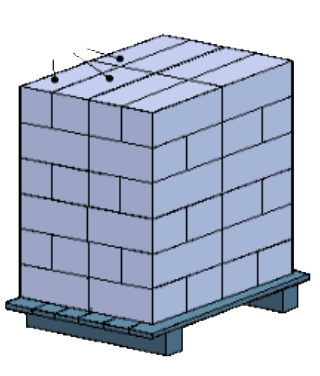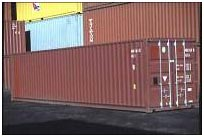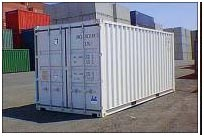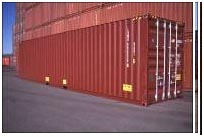Blog

We have excellent service contract with shipping lines it allow us to offer very competitive rates to our customers.
How & Why to Palletize
Palletizing is regarded as a sure-safe way of dispatching cargo consignments, therefore we recommend palletizing your goods to ensure proper safety and timely delivery of your shipment. Although palletizing slightly increases the volume of your shipment, it benefits far outweigh this increment in terms of ease in handling and storage efficiency at the dock(s) and in transit.
Pallet Dimensions:
• The standard pallet size is 48’ (length) by 40’ (width)
• The thickness of the pallet varies from 5”-7”.
How to Palletize :
The ideal situation would involve palletizing a box that is 24” (length) x 18” (width) x 24” (height). The upper limit for a pallet’s height is 62” (if shipping by Air) and 88” (if shipping by Sea) whereas each individual pallet’s weight should not exceed 1500 Lbs.
You can stack four boxes with these dimensions in one layer,so this means that one standard pallet can accommodate a maximum of three layers of boxes with the aforementioned dimensions, with four boxes in each layer.
Even though we transport consignments in a variety of shapes and sizes, our objective is to ensure optimal utilization of storage space while loading shipments.
What You Need To Properly Palletize Your Goods:
• A solid, sturdy pallet
• Strapping materials such as ratchet straps, rope or twine
• A roll of shrink (or stretch) wrap
• Cardboard and/or foam (optional).

Why You Should Palletize:
• Pallets are stronger than other shipping containers such as cardboard boxes and plastic wrapping which reduces the risk of product damage and human injury.
• Pallets keep your goods up and off the ground; this prevents any potential damage from contact with water, dirt, or debris.
• There are a range of lightweight wooden and plastic pallets available which can reduce your cost of warehousing or weight-based shipping cost(s).
• Palletizing enables stability and prevents any unwanted movement of cargo as it is secured with straps and wraps.
• Palletization enables easier tracking of shipments because there are fewer objects to be monitored; it enables flexibility and optimal utilization of storage space.
• Pallets often do not require specialized handling equipment; Palletized goods also require less manual handling as compared to other containers and can therefore be moved much more quickly.
• In case of fresh and/or perishable products, palletization provides drainage and circulation and reduces the risk of temperature abuse on unrefrigerated docks.
• If you are shipping commercial goods, customers tend to prefer receiving palletized goods.
Pallets (especially timber pallets) offer environmental advantages; they are sustainable packaging materials, can be easily repaired using low cost technologies and are recyclable at the end of their useful lives.
What is FCL?
FCL stands for Full Container Load cargo and is a term used to refer to shipments with a full container load. The most common container options for household goods and personal effects are 20’, 40’ and 40’ Hi Cube. Container capacity and other details are explained in detail in a later section.
What are the common container sizes for household item shipments?
The most common container options for personal effects are 20’, 40’ and 40’ Hi Cube.
 20’
20’
 40’
40’
 40’ Hi Cube
40’ Hi Cube
20’ Container
To give you an idea of how big a 20’ container is, it can hold 25 average size American refrigerators. A 20’ container can typically hold all items in a medium sized (2 bed room) apartment or house. That includes the typical amount of boxes used to hold all the various personal effects belonging to two adults and perhaps a child: a lot of books, clothes, dishes, pictures, pillows, rugs extra “stuff” already stored in cartons, and so on…
Let’s say, regarding all those miscellaneous cartons of personal effects, this could be / may be / might be… quite “liberally” estimated … to take up around 300-cubic feet. Since a standard 20-ft ocean container can hold 1,050 – cubic feet of volume, this would mean there would still be a lot of room left over for furniture. Let’s say you want to include a “fair amount” of furniture: a living room set (approximately 300-cft), dining room set (150-cft), a bed room set (200-cft), misc. stored goods (100-cft). This equals approx. 750-cubic feet.
Combine about 750-cft of furniture with 300-cft of personal effects and this gives you a fully loaded 20-foot container.
Dimensions of a 20′ container:- Length: 5.919m Width: 2.340m Height: 2.380m
To calculate the volume you multiply them together: 5.919 x 2.340 x 2.380 = 32.96cbm
Smart Shipper Tip # 1:If your estimated volume is between 1050 Cu Ft and 1250 Cu Ft then you may save money going for a 20’ container instead of a 40’ container if you prioritize your items as ‘Essentials’ and ‘Nice to Haves’ and ensure that the essentials are packed and loaded first. If you have space left you can load in your nice to haves.
40′ Container
A 40’ container can hold larger (3-4) bedroom household items. In addition to the above you can ship a second pair of couches, bed room set, large appliances, barbecue grill and additional 50 – 75 boxes.
The dimensions of a standard 40′ General Purpose container are as follows:-
Length: 12.051m Width: 2.340m Height: 2.380m (12.051 x 2.340 x 2.380 = 67.11cbm)
Same applies when loading as with a 20′, drop roughly 5 cbm to be safe with your capacity if you are planning a shipment.
Smart Shipper Tip # 2: 40’ containers do not cost twice as much even though they offer two times the capacity. Ocean freight and destination services for 40’ containers usually cost only approx 60% more than 40’ containers so you may want to factor this into your calculation when determining container size.
40′ Hi Cube Container
The length and width of a 40’ Hi Cube container are similar to a 40’ Standard but you get an extra 1 feet in height. This translates to an additional 8 CBM or 280 Cu Ft of loading volume.
Smart Shipper Tip # 3: Ocean freight fora 40’ Hi Cube container costs the same as a 40’ standard container.
7′ 8.625″
2.353 m
| Container | Capacity | Recommended load volume | |||||
| Nominal Dimension | Length | Width | Height | Cubic Feet | Cubic Meter | Cubic Feet | Cubic Meter |
| External | 20′ 6.096 m | 8′ 2.438 m | 8′ 6″ 2.591 m | ||||
| Internal | 19′ 4.25″ 5.899 m | 7′ 10″ 2.388 m | 1170 cft | 33.131 cbm | 1050 cft | 28 cbm | |
| External | 40′ 12.192 m | 8′ 2.438 m | 8′ 6″ 2.591 m | ||||
| Internal | 39′ 5.375″ 12.024 m | 7′ 8.625″ 2.353 m | 7′ 10″ 2.388 m | 2385 cft | 67.535 cbm | 2050 cft | 58 cbm |
| External | 40′ Hi Cube 12.192 m | 8′ 2.438 m | 9′ 6″ 2.896 m | ||||
| Internal | 39′ 5.375″ 12.024 m | 7′ 8.625″ 2.353 m | 8′ 10″ 2.692 m | 2690 cft | 76.172 cbm | 2350 cft | 66 cbm |
• Containers with the same external length may not have exactly the same internal length and width.
• The Recommended Load Volume (RLV) refers to the suggested maximum cube to use in calculating a full container load.
• The RLV can be about 10-15% less than the container capacity, depending on the export pack dimensions.
Difference between Customs Clearance and Customs Duty
The words Customs Clearance in your quote should not be confused with Customs Duty. Customs duty is a charge levied on your shipment by the Central Board of Excise and Customs in India. Smart Shipper Tip # 9: You can get concessions on duty if you are eligible for Transfer of Residence (TR). See next question for more on TR.
Customs clearance is the process where we act as a licensed clearing agent on your behalf and provide the following services.
• Getting the Delivery Order for your container from the Steamship line
• Presenting the Delivery Order to Customs and your Bill of Lading to customs and filing a manifest for your shipment
• Arranging for the container to be trucked to the customs bonded warehouse for inspection
• De-stuffing your pallets using a fork lift
• Arranging for customs inspection of your shipment
• Remitting duty with customs after we receive payment from you
• Sending you the official customs receipt
• Arranging for your items to be re-packed and loaded for delivery after customs inspection
Can I ship my automobile (car or motorcycle) to India?
You may ship right hand drive cars and motorcycles. Left hand drive cars (US and Canada) are not allowed to be imported into India unless it is for diplomats. Automobiles are subject to significantly higher rates of duty. We do not ship automobiles from USA to India at this time due to the complexity and risks involved.
Below are the requirements for those planning to ship Automobiles:
Import of ONE used vehicle (car or motor cycle) is allowed to an individual who is coming to India on Permanent Settlement.
• The import shall be subject to the following conditions:
• The importer must be coming to India for permanent settlement after two years continuous stay abroad.
• The car/motorcycle/vehicle (Jeep/SUV etc) must have been in the importers possession or ownership for more than 1 year prior to import.
• The motor car must have right hand steering & controls (not applicable to two or three wheelers).
• The importer must file a bond with customs that the vehicle will not be sold for a period of two years from the date of import.
The following documents and information is required for the clearance of such vehicles imported to India:
• Original manufacturers invoice / value evidence / price list.
• Original passport.
• Residence proof (property papers, rent receipt, electric bill etc).
• Original bill of lading.
• Vehicle catalogue/brochure/write up/owners manual etc.
• Keys of the vehicle (incl remote alarm activator/deactivator).
• Physical location of engine number on the vehicle.
• Physical location of chassis number on the vehicle.
• List of standard accessories available with the vehicle.
• List of optional accessories imported with the vehicle.
• Evidence of the actual freight paid.
• Insurance policy / certificate.
• Authority letter in our favor.
• Signatures on import declaration forms.
Worldwide Ocean & Air Shipping Lines INC. is a LCL consolidator for India for hassle-free shipment and door-to-door shipment. We are the best LCL Consolidators for India. We provide finest LCL logistics & FCL container services. Worldwide Ocean & Air Shipping Lines INC. is the most affordable shipment firm in Relocating from USA to India. Do contact us is you are Relocating from USA to India & we will take care of all your shipping worries.
Licenses, Memberships and Accreditations:
- We are licensed, bonded and insured by the Federal Maritime Commission (FMC) as an NVOCC and Freight Forwarder. Our FMC# is 12678N
- We are also licensed, bonded and insured by the Federal Motor Carrier Safety Administration (FMCSA). Our MC #410339 & Our US DOT#782549.
- We are official packers & movers for Embassies, Missions & Banks.
- We are a Better Business Bureau (BBB) accredited business. We have maintained an A+ rating with the BBB for many years.


All rights reserved at Worldwide Ocean Air Shipping Lines INC.
Designed by Mirackle Solution












